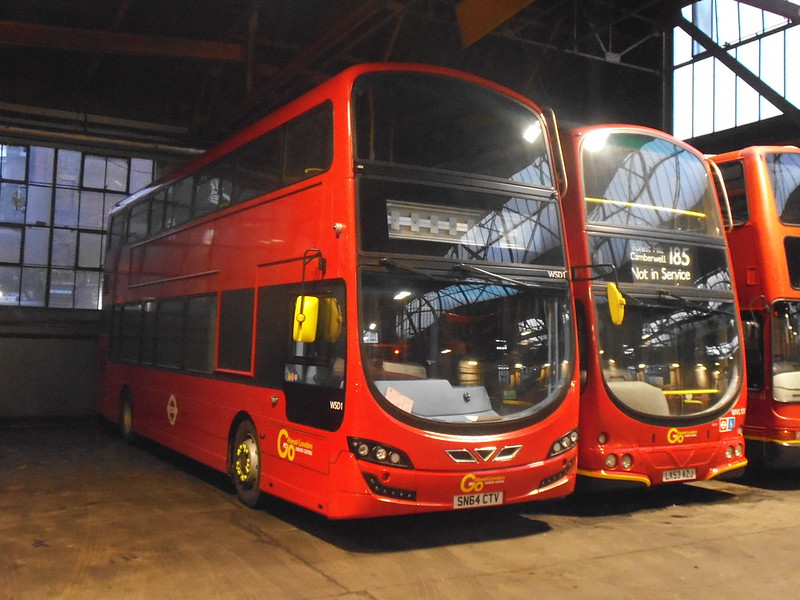London has a new vehicle in WSD1 SN64 CTV a Wrightbus Gemini 3 mounted to an integral Chassis, fitted with a 5 litre Mercedes engine, but of course, that's too much to utter in one mouthful, so lets just stick to calling in the 'Streetdeck' as advertised on Wrightbus' website. The vehicle almost slipped underneath the radar, if not for someone who reported it running around the Camberwell area after being delivered on the 9th of February. Here for extensive trials against its Volvo counterpart 'V6' another Wrightbus bodied Gemini 3, it will be allocated duties on the 12 (which could of been guessed) and the 45.

At present it awaits blinds and an Oyster card machine, before being commissioned into service here at Camberwell garage. Visually it is identical to its counter part with the only obvious give-away being the fact it is liveried in Go Ahead London colours. This 10 ton beast, well 10,839kgs is the first and second of its kind in London, if you're the pedantic sort, you'd say Arriva's DW411 LJ11 AEB technically comes first, and as I was told today, mechanically, is not much indifferent to the NRMs currently whizzing up and down the streets of London today. Although I do admit it is quite worrying seeing a modern day double decker with a weight of just under 11 tons, I must say the thing feels as steady as any other Wright product and definitely represents one of the many positives brought forth with the 'Streets Ahead' project which sparked this dramatic need for weight reduction on the manufacturer's vehicles.
A thanks must go out to the guys and girls at this very large base, although its not everyday you are told an E400 is the best bus in terms of reliability and that a Volvo B9TL is awful, which was quite odd to hear, with the engineering manager, quoting the former Mandela Way batch as 'dream' machines, which I reluctantly had to agree with...On a day to day basis, the garage manages vehicles from all aspects within the company's fleet, so its always a pleasure to visit...I think this is visit number three!
Although the garage was opened in 1914, it did not operate a single bus service for much over 5 years when it was requisitioned for the war. However when it did start to operate, it became one of the largest garages in London, the mammoth base was used to carry out body overhauls in 1940s, however in that said year, it was severely damaged following a bomb attack during the war. Following the attack, 13 vehicles were seriously damaged while four were completely destroyed. A write up of the garage can be read below.
The garage was promptly repaired, however in early 1950s the garage underwent a modernisation programme which is sounds funny to say considering the 1950s was so many moons ago. However the programme included the reconstruction of the welfare and operational block, with the addition of a new extended parking area which greatly increased capacity of the garage. The new and improved facilities incorporated a new pit and workshop which also took on the duties of heavy maintenance for the Walworth Garage ironically situated across the road from the base. The changes took the the capacity of the garage to a respectable 350 buses.
Despite its mammoth size, the allocation steadily decreased over the years as many routes were shifted out, until the closure of Walworth garage in 1985. This saw the allocation of vehicles rise back up to 142, although a shadow of the amount it did operate in the 1950s, which was close enough to 200 buses.
For a bit of trivia, the garage held three Leyland Titans, that were fitted with electronic blinds on an experimental basis. The vehicles were used on night bus standby duties. A selection of the photos taken today can be viewed below.
 |
| Go Ahead London Pointer |
 |
| Go Ahead London PVL302 PJ02 RFX |
 |
| Go Ahead London WHY7 LX57 CLZ |
 |
| Go Ahead London PVL86 W486 WGH |
 |
| Go Ahead London LDP260 SN53 KXY |
 |
| The forecourt of Camberwell Bus Garage |
 |
| Go Ahead London LDP206 SN51 UAY |
 |
| Go Ahead London PVL338 PJ52 LWT |












0 Comments:
Post a Comment
Please comment responsibly